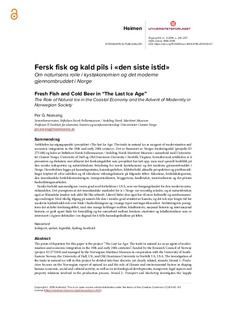| dc.contributor.author | Norseng, Per G. | |
| dc.date.accessioned | 2019-10-25T08:57:12Z | |
| dc.date.available | 2019-10-25T08:57:12Z | |
| dc.date.created | 2019-10-17T17:33:35Z | |
| dc.date.issued | 2019 | |
| dc.identifier.citation | Heimen - Lokal og regional historie. 2019, 56 (3), 214-237. | nb_NO |
| dc.identifier.issn | 0017-9841 | |
| dc.identifier.uri | http://hdl.handle.net/11250/2624384 | |
| dc.description | This is an open access article distributed under the terms of the Creative Commons CC-BY-NC 4.0 License | nb_NO |
| dc.description.abstract | Artikkelen tar utgangspunkt i prosjektet «The last Ice Age: The trade in natural ice as an agent of modernisation and economic integration in the 19th and early 20th century». Det er finansiert av Norges forskningsråd (prosjekt-ID 275188) og ledes av Stiftelsen Norsk Folkemuseum / Avdeling Norsk Maritimt Museum i samarbeid med Universitetet i Sørøst-Norge, University of Hull og Old Dominion University i Norfolk, Virginia. Formålet med artikkelen er å presentere og diskutere mer allment det forskningsfeltet som prosjektet har tatt opp, men med spesielt henblikk på den norske iseksporten og naturisbrukens betydning for norsk kystøkonomi og det moderne gjennombruddet i Norge. Hovedvekten legges på kunnskapsstatus, kunnskapsbehov, kildeforhold, aktuelle perspektiver og problemstillinger knyttet til selve isdriften og til isbrukens virkningshistorie på følgende felter: fiskeriene, ferskfiskeksporten, den innenlandske ferskfiskomsetningen, transportsektoren, bryggeriene, landbruket, meierisektoren og det private husholdningsmarkedet.
Norske forhold sammenlignes i noen grad med forholdene i USA, som var foregangslandet for den moderne naturishandelen. Det poengteres at det innenlandske markedet for is i Norge var vesentlig mindre, og at naturisbruken også av klimatiske årsaker nok aldri ble like utbredt. Likevel bidro den også her til store kulturelle og samfunnsmessige endringer. Med rikelig tilgang på naturis ble den i mindre grad erstattet av kunstis, og det tok mye lengre tid før moderne kjøleteknikk tok over både i husholdningene og i mange typer næringsvirksomhet. Avslutningsvis poengteres det at dette forskningsfeltet, med sine mange koblinger mellom lokalhistorie, nasjonal historie og internasjonal historie, er godt egnet både for formidling og for samarbeid mellom forskere, studenter og lokalhistorikere som er interessert i å gjøre delstudier i en dugnad for å fylle kunnskapshullene på feltet | nb_NO |
| dc.description.abstract | The point of departure for this paper is the project “The Last Ice Age: The trade in natural ice as an agent of modernisation and economic integration in the 19th and early 20th centuries”, funded by the Research Council of Norway (project ID 275188) and managed by the Norwegian Maritime Museum in cooperation with the University of South-Eastern Norway, the University of Hull, UK, and Old Dominion University in Norfolk VA, USA. The investigation of the trade in natural ice will in this project be divided into four discrete, yet closely related, strands: Strand 1: Production focuses on the Norwegian export of natural ice and the role of climate and environmental factors in shaping human economic, social and cultural activity, as well as on technological developments, manpower, legal aspects and property relations involved in the production process. Strand 2: Transport and Marketing investigates the ‘supply chain’ by land and sea that linked centres of ice production with ever extending markets. Strand 3: Consumption Patterns analyses the contribution of natural ice in the improvement of food supplies, health conditions and standards of living, with Britain, France and Norway as case study. Strand 4: Ice and Modernization analyses the impact of natural ice on societal taste, fashion and aesthetics, and the studies of this commodity in driving cultural and technological developments. The wide scope of the project offers ample opportunities for colleagues and students to join in. By connecting local history with international history, the outcomes lend themselves easily to dissemination to the public. The purpose of this paper is to discuss the research potential in this field more generally, with special regard to Norway, and attract interest in further research by local historians and university students as well as academics. | nb_NO |
| dc.language.iso | nob | nb_NO |
| dc.rights | Navngivelse-Ikkekommersiell 4.0 Internasjonal | * |
| dc.rights.uri | http://creativecommons.org/licenses/by-nc/4.0/deed.no | * |
| dc.title | Fersk fisk og kald pils i «den siste istid» – om naturisens rolle i kystøkonomien og det moderne gjennombruddet i Norge | nb_NO |
| dc.type | Journal article | nb_NO |
| dc.type | Peer reviewed | nb_NO |
| dc.description.version | publishedVersion | nb_NO |
| dc.rights.holder | Copyright © 2019 Author(s). | nb_NO |
| dc.source.pagenumber | 214-237 | nb_NO |
| dc.source.volume | 56 | nb_NO |
| dc.source.journal | Heimen - Lokal og regional historie | nb_NO |
| dc.source.issue | 3 | nb_NO |
| dc.identifier.doi | 10.18261/issn.1894-3195-2019-03-07 | |
| dc.identifier.cristin | 1738134 | |
| dc.relation.project | Norges forskningsråd: 275188 | nb_NO |
| cristin.unitcode | 222,57,4,0 | |
| cristin.unitname | Institutt for økonomi, historie og samfunnsvitenskap | |
| cristin.ispublished | true | |
| cristin.fulltext | original | |
| cristin.qualitycode | 1 | |

